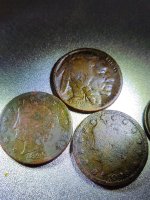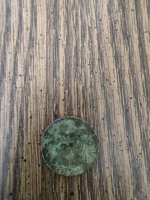spacetimecont
Newbie
- Jan 15, 2005
- 3
- 0
I'm sure this has been brought up before, but I wanted to offer some suggestions and make it clear.
I'm a numismatist (I study coins and money) from the NGC and PCGS forums. PCGS and NGC are the 2 top grading and authentication companies that, will, for a fee, authenticate and grade your coins. This is especially important for gold coins as US gold coins are often counterfeited.
Coins are either "raw" or certified. Certified means they are in what is known as a slab. When you send a coin to a grading service they will put the coin in inert plastic to protect the coin as well as grade on the coin. NGC and PCGS do not slab problem coins (i.e coins that have been cleaned or been scratched. Well I'll take that back. Recently PCGS decided to certify coins (problem coins) as geniune for a very high fee. Of course you have to already know it is a geniune problem coin before submitting it since you hav to mark it as such)
ANACS does though. They used to do net grading. I.e if the coin has been scatched for example, they will slab it and put the estimated grade of the coin, the net grade, and the grade on what the coin would be without the problem. For example, I submitted a scratched gold sovereign. It came back NET AU55 (About uncirculated) UNC details (Uncirculated details).
ANACS recently moved and they no longer net grade coins, however; they do grade problem coins.
Often times counterfeiters will take a well worn $20 gold piece that is geniune (which is 900 fine, 22 karat, almost 1 oz) melt it down and make a bunch of smaller, higher numismatic gold coins which they can sell inviduauly with a higher numismatic value than the bigger $20 gold piece. For example, $2.5 indians. Or the tiny $1 gold dollar coins which have a huge premium over the melt value of the coins.
The grading scale goes from Poor 1 (where only the outline of the details of the coin is visible) to mint state, which has no wear. From there, mint state goes from 60 (which means the coin has many distracting marks) to mint state 70, which is a coin with a perfect strike, no marks, hairlines, etc.
There is also another condition of a coin, which really isn't a grade, but rather a method of manfucuturing the coin called proof. Proof coins are struck multiple times with dies, and have a mirror finish. The mint sells proof mint sets you can order from www.usmint.gov
Some advice:
Whatever you do, if you find a coin or gold coin, DO NOT clean it! This will reduce the value of the coin about half. Since this is a metal detecting forum, often times you will find coins that have verdigris on them or are dirty. You can soak them in olive oil and this will get most of the dirt off.
Do not rub the coin with a clothe. This can result in tiny scratches called hairlines which effect the grade.
Always hold a coin by the edges. Fingerprints can damage a coin. Do not breathe out while holding a coin, the mostiure from you breathe can get on the coin. Avoid high humid temperatures, try and get a humidity controlled safety despoit box for valueable coins.
To detect counterfeit gold coins (I doubt you'd find many fake gold ones since they are not contempoary counterfeits)
1. Look for sharp crisp letters on the obverse and reverse of the coin. Counterfeits often have mushy details.
2. Look for repeating depressions on the coin. Depressions are pits in the coin which were bagmarks (hits) on the orgininal die of the coin.
3. Look for toolmarks in the protected areas of the coin. Toolmarks are spots on a coin die where a counterfeiter might have seen a blob of metal on the die and tried to fix it. This results in short, stubby raised lines. Do not confuse toolmarks with die polish, which many geniune coins have resulting from highly polishing their dies.
4. Looking for even denticals. Denticals are around the edge of the coin. Counterfiet coins sometimes have uneven denticals.
5. Look for spikes from the denticals. Most counterfeits have this, although about 2% of geniune coins have it too.
Let me know if you have any questions. I hope this post was helpful. I will try to identify coins for people who find them.
I'm a numismatist (I study coins and money) from the NGC and PCGS forums. PCGS and NGC are the 2 top grading and authentication companies that, will, for a fee, authenticate and grade your coins. This is especially important for gold coins as US gold coins are often counterfeited.
Coins are either "raw" or certified. Certified means they are in what is known as a slab. When you send a coin to a grading service they will put the coin in inert plastic to protect the coin as well as grade on the coin. NGC and PCGS do not slab problem coins (i.e coins that have been cleaned or been scratched. Well I'll take that back. Recently PCGS decided to certify coins (problem coins) as geniune for a very high fee. Of course you have to already know it is a geniune problem coin before submitting it since you hav to mark it as such)
ANACS does though. They used to do net grading. I.e if the coin has been scatched for example, they will slab it and put the estimated grade of the coin, the net grade, and the grade on what the coin would be without the problem. For example, I submitted a scratched gold sovereign. It came back NET AU55 (About uncirculated) UNC details (Uncirculated details).
ANACS recently moved and they no longer net grade coins, however; they do grade problem coins.
Often times counterfeiters will take a well worn $20 gold piece that is geniune (which is 900 fine, 22 karat, almost 1 oz) melt it down and make a bunch of smaller, higher numismatic gold coins which they can sell inviduauly with a higher numismatic value than the bigger $20 gold piece. For example, $2.5 indians. Or the tiny $1 gold dollar coins which have a huge premium over the melt value of the coins.
The grading scale goes from Poor 1 (where only the outline of the details of the coin is visible) to mint state, which has no wear. From there, mint state goes from 60 (which means the coin has many distracting marks) to mint state 70, which is a coin with a perfect strike, no marks, hairlines, etc.
There is also another condition of a coin, which really isn't a grade, but rather a method of manfucuturing the coin called proof. Proof coins are struck multiple times with dies, and have a mirror finish. The mint sells proof mint sets you can order from www.usmint.gov
Some advice:
Whatever you do, if you find a coin or gold coin, DO NOT clean it! This will reduce the value of the coin about half. Since this is a metal detecting forum, often times you will find coins that have verdigris on them or are dirty. You can soak them in olive oil and this will get most of the dirt off.
Do not rub the coin with a clothe. This can result in tiny scratches called hairlines which effect the grade.
Always hold a coin by the edges. Fingerprints can damage a coin. Do not breathe out while holding a coin, the mostiure from you breathe can get on the coin. Avoid high humid temperatures, try and get a humidity controlled safety despoit box for valueable coins.
To detect counterfeit gold coins (I doubt you'd find many fake gold ones since they are not contempoary counterfeits)
1. Look for sharp crisp letters on the obverse and reverse of the coin. Counterfeits often have mushy details.
2. Look for repeating depressions on the coin. Depressions are pits in the coin which were bagmarks (hits) on the orgininal die of the coin.
3. Look for toolmarks in the protected areas of the coin. Toolmarks are spots on a coin die where a counterfeiter might have seen a blob of metal on the die and tried to fix it. This results in short, stubby raised lines. Do not confuse toolmarks with die polish, which many geniune coins have resulting from highly polishing their dies.
4. Looking for even denticals. Denticals are around the edge of the coin. Counterfiet coins sometimes have uneven denticals.
5. Look for spikes from the denticals. Most counterfeits have this, although about 2% of geniune coins have it too.
Let me know if you have any questions. I hope this post was helpful. I will try to identify coins for people who find them.




